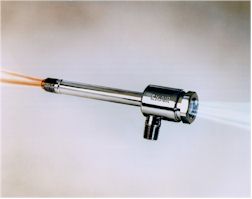 |
Vortex
Tubes |
|

|
Cold
air to -50°F (-46°C) from your compressed air supply -- with no
moving parts!
Low cost, reliable, maintenance-free
solution to a variety of industrial spot cooling problems. Using
an ordinary supply of compressed air as a power source, vortex tubes
create two streams of air, one hot and one cold, with no moving
parts. Vortex tubes can produce:
- Temperatures from -50°
to +260°F (-46° to +127°C)
- Flow rates from 1 to
150 SCFM (28 to 4248 SLPM)
- Refrigeration up to
10,200 Btu/hr. (2571 Kcal/hr.)
 Vortex
Tube Brochure Vortex
Tube Brochure
|
| EXAIR Vortex Tubes are constructed
of stainless steel. The wear resistance of stainless steel,
as well as its resistance to corrosion and oxidation, assures that
EXAIR Vortex Tubes will provide years of reliable, maintenance-free
operation. |
- Cooling
electronic controls
- Cooling
machining operations
- Cooling
CCTV cameras
- Setting
hot melts
- Cooling
soldered parts
- Cooling
gas samples
- Electronic
component cooling
- Cooling
heat seals
- Cooling
environmental chambers
|
- No
moving parts
- No
electricity or chemicals
- Small,
lightweight
- Low
cost
- Maintenance
free
- Instant
cold air
- Durable
- stainless steel
- Adjustable
temperature
- Interchangeable
generators
|
|
| Compressed air, normally
80-100 PSlG (5.5 - 6.9 BAR), is ejected tangentially through a
generator into the vortex spin chamber. At up to 1,000,000
RPM, this air stream revolves toward the hot end where some escapes
through the control valve. The remaining air, still spinning,
is forced back through the center of this outer vortex. The inner
stream gives off kinetic energy in the form of heat to the outer
stream and exits the vortex tube as cold air. The outer
stream exits the opposite end as hot air. There is a detailed
discussion of vortex tube history and theory later in this section. For more details on the theory
behind vortex tubes, click
here. |
 |
| Cold airflow and temperature
are easily controlled by adjusting the slotted valve in the hot
air outlet. Opening the valve reduces the cold airflow and
the cold air temperature. Closing the valve increases the cold
airflow and the cold air temperature. The percentage of air
directed to the cold outlet of the vortex tube is called the "cold
fraction". In most applications, a cold fraction of 80% produces
a combination of cold flow rate and temperature drop that maximizes
refrigeration, or Btu/hr. (Kcal/hr.) output of a vortex tube.
While low cold fractions (less than 50%) produce lowest temperatures,
cold airflow rate is sacrificed to achieve them.
Most industrial applications,
i.e., process cooling, part cooling, chamber cooling, require
maximum refrigeration and utilize the 3200 series Vortex Tube.
Certain "cryogenic" applications, i.e., cooling lab
samples, circuit testing, are best served by the 3400 series Vortex
Tube. Setting a vortex tube is
easy. Simply insert a thermometer in the cold air exhaust and
set the temperature by adjusting the valve at the hot end. Maximum
refrigeration (80% cold fraction) is achieved when cold air temperature
is 50°F (28°C) below compressed air temperature. |

|
| Temperatures, flows
and refrigeration are adjustable over a wide range using the control
valve on the hot end exhaust. |
 |
 |
 |
 |
| |
Special high temperature
vortex tubes keep a boroscope lens cool while inserted into a 1200°F boiler porthole. |
A Model 3215 Vortex
Tube cools a die on a medical tube forming machine. |
|
| |
|
|
|
|
|
|
|
|
|
| |
| Important Notice:
By purchasing products from this Site, you acknowledge and agree that
you have read and accept the Terms and Conditions of this online store.
For more information email us at: info@iprocessmart.com |
|
|
|
|







